A Lighter Shade of Siren
Even though the "Blood Curse" still takes place in a remote Japanese village, the story is now told from a westerner point of view, with its main characters being of US origin. This choice inevitably leads to some awkward cheesiness in dialogue and to the occasional critique to Hollywood cinematography, both of which end up marring the horror background, that doesn't mix well either with comedy or parody. The story-line was also simplified, featuring less characters and dialogue; needless to say, much of the nuances and deeper meanings were lost in translation. The narrative structure in itself is detrimental to Toyama's tale; by using a TV show / DVD episode structure (similar to that of the appalling "Alone in the Dark"), the game became much more focused on dramatic events, such as cliffhangers, instead of delving into psychological horror elements. Also, the Hollywood-like editing, which favors an economic use of time over density and characterization, makes the action go by super-fast, leaving no time for the fleshing out of the ambiance that made "Siren" unique. The surreal vibe is thus lost, and with it, much of the psychological impact of its horror mind-games. What all these flaws amount to, like in most Japanese horror movie remakes, is a work that feels like a fast-food version of the original, lacking all the subtlety that made it unique in the first place.
In terms of actual game, the crossing over to western audiences does more good than bad. Previous "Siren" games were known of their complex game-play, and their frequently obtuse level-design. "Blood Curse" alleviates some of this burden by making game-play more accessible and well balanced, and also by decreasing the number of stealth portions in favor of action-adventure segments. This makes the game easier to enjoy, and smoother in its overall experience. Which is not to say that many of the flaws of the original games aren't present. The objective-by-objective design of each level, which forces you to explore exactly as the designers want you to, still makes the game feel like an overlong tutorial. Worse still, is when the designers don't make their logic apparent, giving you obtuse objectives for which there are no clues on how to tackle them. But these would be small nags if the overall design worked, but sadly, even after 3 games in the series, it still misses the point entirely. Stealth inevitably leads to trial and error, which in turn, breaks pacing and mood (obligatory in the creating a good horror ambiance) and the consistently closed level design (a consequence of the Simon-says design) destroys any chance of proper exploration, which could serve to build-up tension and anticipation of danger. In the end, this third iteration of "Siren" only serves to prove that the original design was too crooked to fix in the first place, and not even a vast amount of polish, such as the one in "Blood Curse", can fix it.
Despite its terrible, sometimes infuriating faults, "Siren" still manages to reward its players in a way that no recent survival horror game does. No matter how much the game-design gets in the way, the horror aesthetic still comes through, and that is enough to make you feel what every horror game should make you feel: terror. And the horror aesthetic is exactly where "Siren" shows the superlative artistry of its authors. From its depiction of a derelict Japanese village, so damp, dirty and moist, that you can almost smell the stench of the gruesome, nauseating monsters that prowl about, to the natural elements like rain, wind, thunder, sunlight at dawn, all captured with perfect audio-visual fidelity, the game makes every set-piece look dark and disturbing. The violence itself, is as strange and surreal as you've come to expect from good Japanese horror movies (though it's a shame that outside Japan, the game is slightly censored). Simply put, every piece of art and music blends beautifully into a menacing, unsettling experience of horror that will make you shiver in fright and disgust. It's certainly one of the finest art designs of this generation, and it takes full advantage of the processing capabilities offered by the new Playstation.
It's hard not to have a love-hate relationship with the "Siren" series. Its stealth meets survival horror game-design never made any sense, and its increasingly watered-down versions in both "Forbidden Siren 2″ and "Blood Curse", while more pleasing, are still far from providing a good basis of interaction for the aesthetic and narrative dimensions. But on the other hand, you have to hand it down to Toyama for maintaining the survival horror spirit intact, foregoing the action non-sense that is all the rage nowadays. "Blood Curse" is a real survival horror game, and considering the genre's current landscape, that's the greatest compliment any survival horror game can receive.

